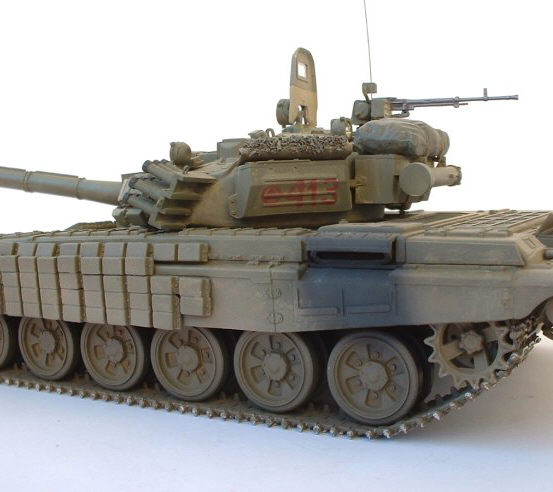Modelling Zvezda’s 1/35 T-72B/EDZ
by Thomas Johansson
Many of us Swedes remember how it was to grow up in the shadow of the Red Bear, that is probably the main reason why many modellers are still intrigued by Russian armour, myself included. In the Swedish Defence military exercises during the cold war the ”enemy” always came from the east, but the names Russia or the Soviet Union were never spoken.
One of the symbols of the Russian armoured fist was the T-72. The T-72 is probably the most recognized tank of the late Red Army period, as it remained in service with the Soviet Union and its satellite states as well as being a large export success.
My model is built to resemble a Russian T-72B/EDZ in a campaign in Chechnya in the 1990’s. EDZ is the Russian acronym for dynamic protection elements, more widely known as ERA – Explosive Reactive Armour. Photos from the Chechen campaigns show the tanks covered in dry mud and dust and packed with equipment; crates, boxes, tarpaulins, camouflage nets and so on. Armour and tanks in peacetime exercises are seldom equipped with add-ons so this was an opportunity for some experimenting.
The Kit
Zvezda is one of my favourite kit brands as they focus of Russian vehicles in a multitude of variants, of which many are disregarded by the western producers. Zvezda’s kits are fair built straight out of the box, but require a bit of effort if you want them to become show stoppers.
The kit I have used for this project is Zvezda 3551 T-72B w/ERA in 1/35 scale, one of three T-72s from this manufacturer. The three are basically the same kit with some sprues replaced and with the older turret in the A-version. As some readers may have noted, Zvezda doesn’t wrap their sprues in plastic bags, which sometimes results in pieces being broken off the sprues. This have happened to me, too and it’s quite irritating, especially if it happens to wheel axles which are moulded together with the bottom hull.
The Zvezda kit was moulded quite crudely and some parts like the smoke grenade rack were difficult to get neat. The parts fit was OK and I didn’t need much filling and sanding. The only part difficult to fix without an add-on was the gun barrel which is too thick in diameter, but that’s only a problem if you want it to be, and I chose to ignore it. Apart from this, I like the Zvezda kits a lot and have built quite a few of them.
The Build
This model was built mainly out-of-the-box, but with little bits and pieces added. Usually I replace items like electric cables (to lamps, smoke mortars etc) and fuel pipes with lengths of copper wire, but on this model many were to be covered by the add-on-armour blocks, so I left out most of them. Some loops and handles were formed from copper wire and attached. I use copper wire from electrical cables, they’re easy to bend and they come in different thickness. A steel wire antenna was added, as were some rear fan cover plates from plastic card. I have also added the transparent window for the commanders turret windscreen from clear Plasticard.
The T-72s in Chechnya were equipped with more EDZ blocks than were provided in the box so a kit of T-80BV had to give up some. The turret stowage was a mix of MR Models and Tamiya items and a homemade camouflage net made of tape, white glue and tea-leaves. The latter is tip I got on the internet, and it can be made to look quite realistic with a little practice.
Colour
Painting Russian armour is not so much a struggle with a complicated camouflage scheme but a hunt for the correct tone of green. As different tank factories and REMO plants (restoration/modification) used different paints it’s really just up to the builder to choose a colour he or she likes.
On this project the model was airbrushed with Gunze Sangyo 303 Green. The base coat was covered with a wash of Humbrol 33 Black to reveal details and then some heavy washes of Humbrol 83 Ochre to try to accentuate all the cracks and spaces between the EDZ tiles and to simulate general dirt.
The entire tank was covered in a light coat of Gunze Sangyo 304 Olive Drab to dull the green base and then a dust layer of Gunze 85 Sail Colour to simulate road dust. The lower parts got the same treatment, only heavier.
The machine gun was painted with a burnt iron base and then covered with Gunze Sangyo 212 Iron and then polished to a nice shine. That paint is one jar I just can’t do without. Graphite pencils are superb for metalizing smaller items but for the larger surfaces I haven’t found a substitute to the Gunze’s no. 212 yet. Another fine paint is Gunze Sangyo 343 Soot which is black, of course, but with a trace of metal which gives a nice look to heavy sooty surfaces.
The track was given a base of GZ76 Burnt iron and then was covered with more ochre. To accentuate general wear, the tracks received some Humbrol 27002 Polished Aluminium. I feel this detail is important to bring a model to life but it’s easy to overdo this stage. Practice, practice, practice.
Final words
If you want a collection of modern Russian/Soviet armour, Zvezda is a manufacturer not to be ignored. Their kits are quite fair and the T-72B/EDZ is no exception. I’m happy with the model and especially with the paint finish. It remains to be seen if Zvezda will release the T-72Bs’ big brother; the T-72BV/T-90. If they do, I’ll have a space on the bookcase shelf waiting for it.
This article was originally published in IPMS Stockholm Magazine in November 2006






